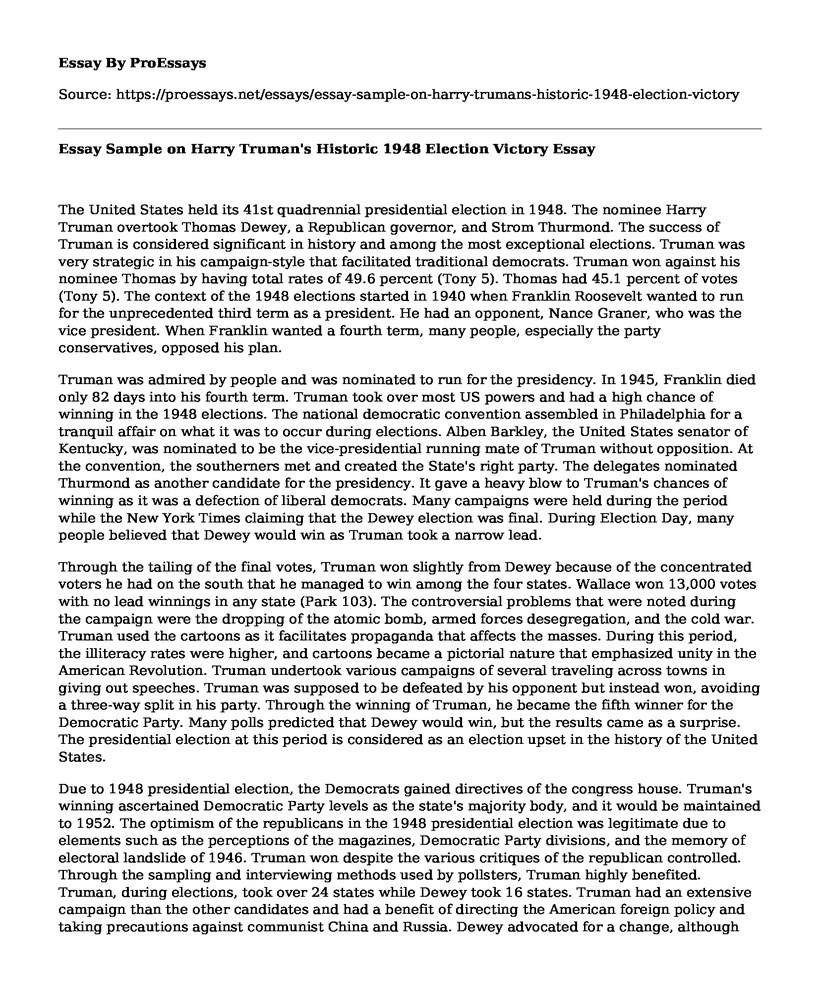The United States held its 41st quadrennial presidential election in 1948. The nominee Harry Truman overtook Thomas Dewey, a Republican governor, and Strom Thurmond. The success of Truman is considered significant in history and among the most exceptional elections. Truman was very strategic in his campaign-style that facilitated traditional democrats. Truman won against his nominee Thomas by having total rates of 49.6 percent (Tony 5). Thomas had 45.1 percent of votes (Tony 5). The context of the 1948 elections started in 1940 when Franklin Roosevelt wanted to run for the unprecedented third term as a president. He had an opponent, Nance Graner, who was the vice president. When Franklin wanted a fourth term, many people, especially the party conservatives, opposed his plan.
Truman was admired by people and was nominated to run for the presidency. In 1945, Franklin died only 82 days into his fourth term. Truman took over most US powers and had a high chance of winning in the 1948 elections. The national democratic convention assembled in Philadelphia for a tranquil affair on what it was to occur during elections. Alben Barkley, the United States senator of Kentucky, was nominated to be the vice-presidential running mate of Truman without opposition. At the convention, the southerners met and created the State's right party. The delegates nominated Thurmond as another candidate for the presidency. It gave a heavy blow to Truman's chances of winning as it was a defection of liberal democrats. Many campaigns were held during the period while the New York Times claiming that the Dewey election was final. During Election Day, many people believed that Dewey would win as Truman took a narrow lead.
Through the tailing of the final votes, Truman won slightly from Dewey because of the concentrated voters he had on the south that he managed to win among the four states. Wallace won 13,000 votes with no lead winnings in any state (Park 103). The controversial problems that were noted during the campaign were the dropping of the atomic bomb, armed forces desegregation, and the cold war. Truman used the cartoons as it facilitates propaganda that affects the masses. During this period, the illiteracy rates were higher, and cartoons became a pictorial nature that emphasized unity in the American Revolution. Truman undertook various campaigns of several traveling across towns in giving out speeches. Truman was supposed to be defeated by his opponent but instead won, avoiding a three-way split in his party. Through the winning of Truman, he became the fifth winner for the Democratic Party. Many polls predicted that Dewey would win, but the results came as a surprise. The presidential election at this period is considered as an election upset in the history of the United States.
Due to 1948 presidential election, the Democrats gained directives of the congress house. Truman's winning ascertained Democratic Party levels as the state's majority body, and it would be maintained to 1952. The optimism of the republicans in the 1948 presidential election was legitimate due to elements such as the perceptions of the magazines, Democratic Party divisions, and the memory of electoral landslide of 1946. Truman won despite the various critiques of the republican controlled. Through the sampling and interviewing methods used by pollsters, Truman highly benefited. Truman, during elections, took over 24 states while Dewey took 16 states. Truman had an extensive campaign than the other candidates and had a benefit of directing the American foreign policy and taking precautions against communist China and Russia. Dewey advocated for a change, although Truman took most parts of the western states. The election led to a change in Civil rights, foreign policy, and organized labor.
Works Cited
Park, Bumjun. "Bias Correction by Sub-population Weighting for the 2016 United States Presidential Election." American Journal of Applied Mathematics and Statistics 5.3 (2017): 101-105. http://www.academia.edu/download/56056807/ajams-5-3-3.pdf
Tony, Jared G. "Contested Ground: The 1948 Presidential Election in Tampa, Florida." Sunland Tribune 30.1 (2018): 5. https://scholarcommons.usf.edu/cgi/viewcontent.cgi?article=1373&context=sunlandtribune
Cite this page
Essay Sample on Harry Truman's Historic 1948 Election Victory. (2023, May 09). Retrieved from https://proessays.net/essays/essay-sample-on-harry-trumans-historic-1948-election-victory
If you are the original author of this essay and no longer wish to have it published on the ProEssays website, please click below to request its removal:
- Research Paper on Corruption in the Healthcare Sector
- Implementation of Changes by Government Paper Example
- Conservatism and Liberalism Essay
- The Impact of Groups and Organizations on Public Policy Paper Example
- Essay Sample on Stability of a Government
- Essay Example on Karl Marx's Class Struggles in France
- Paper Example on US Constitution Prohibits Arrest in Absence of Evidence







